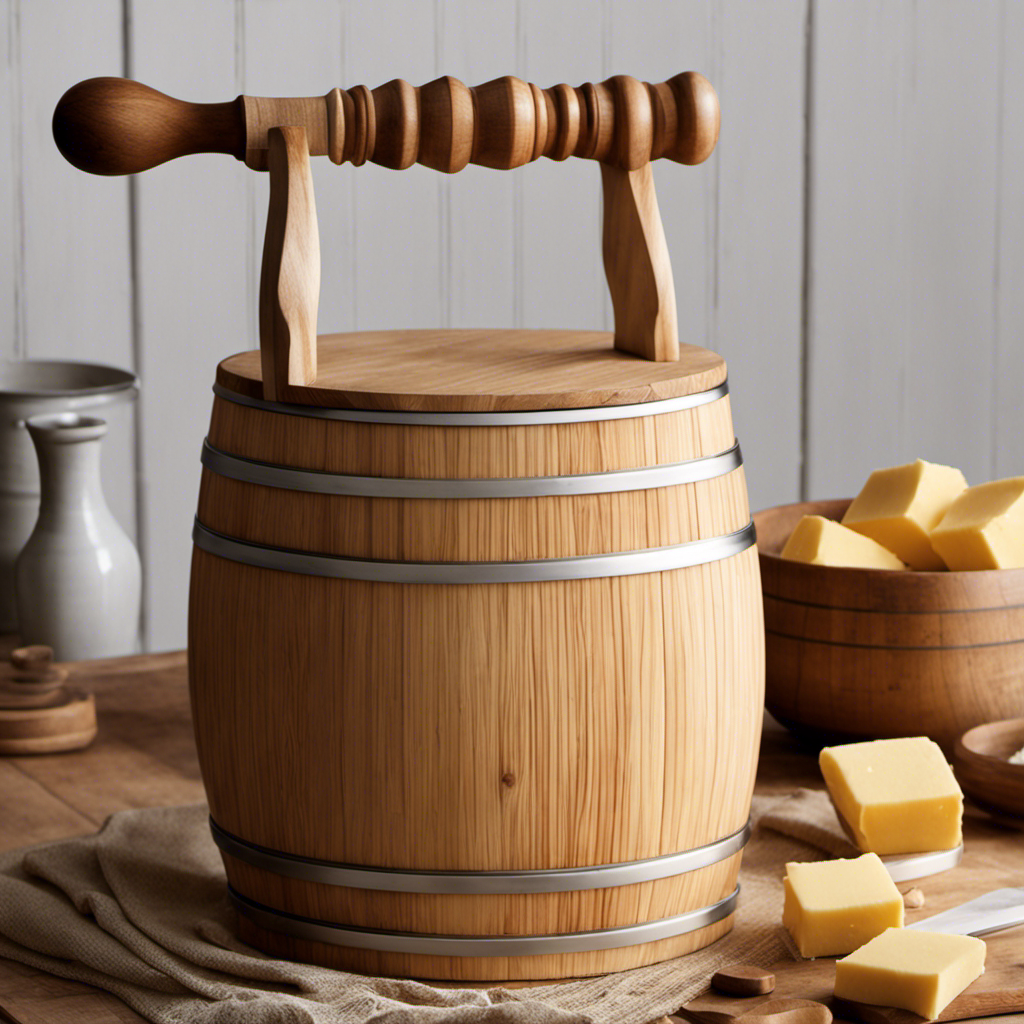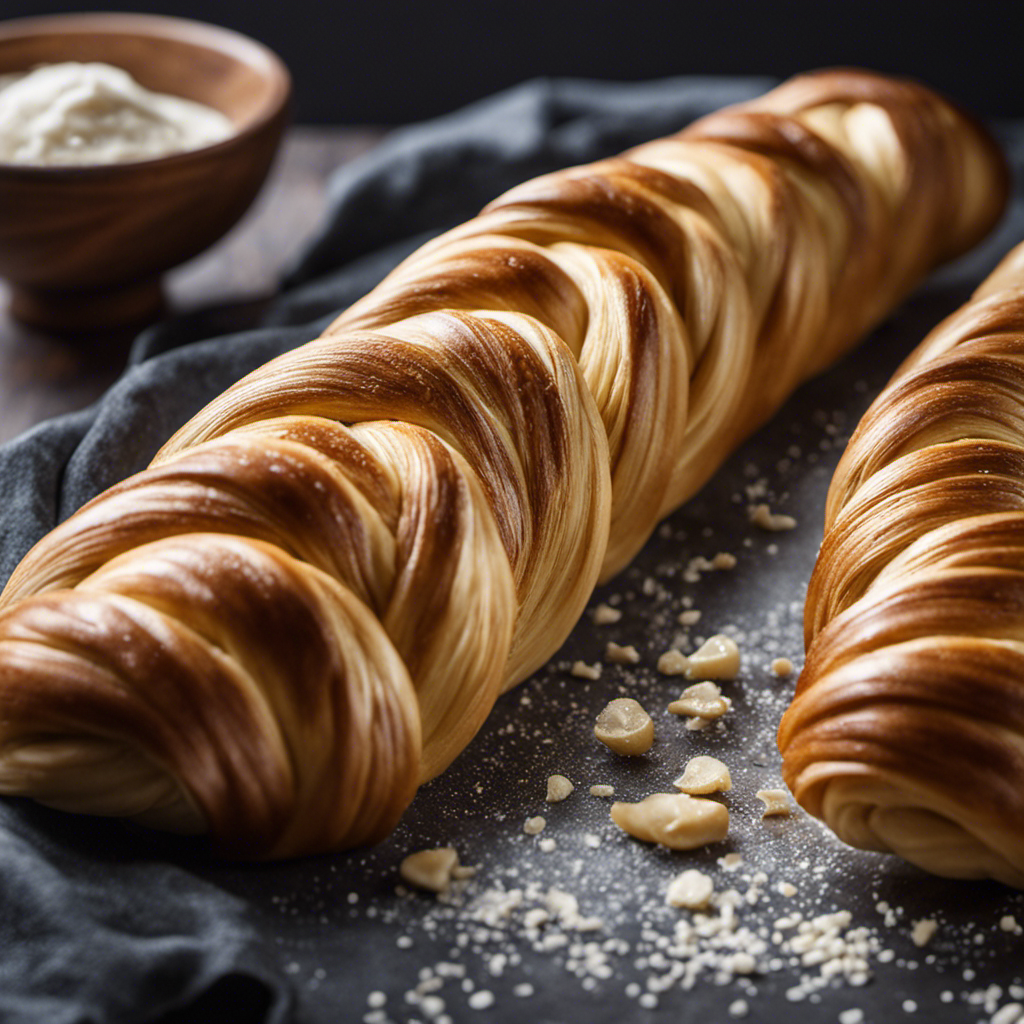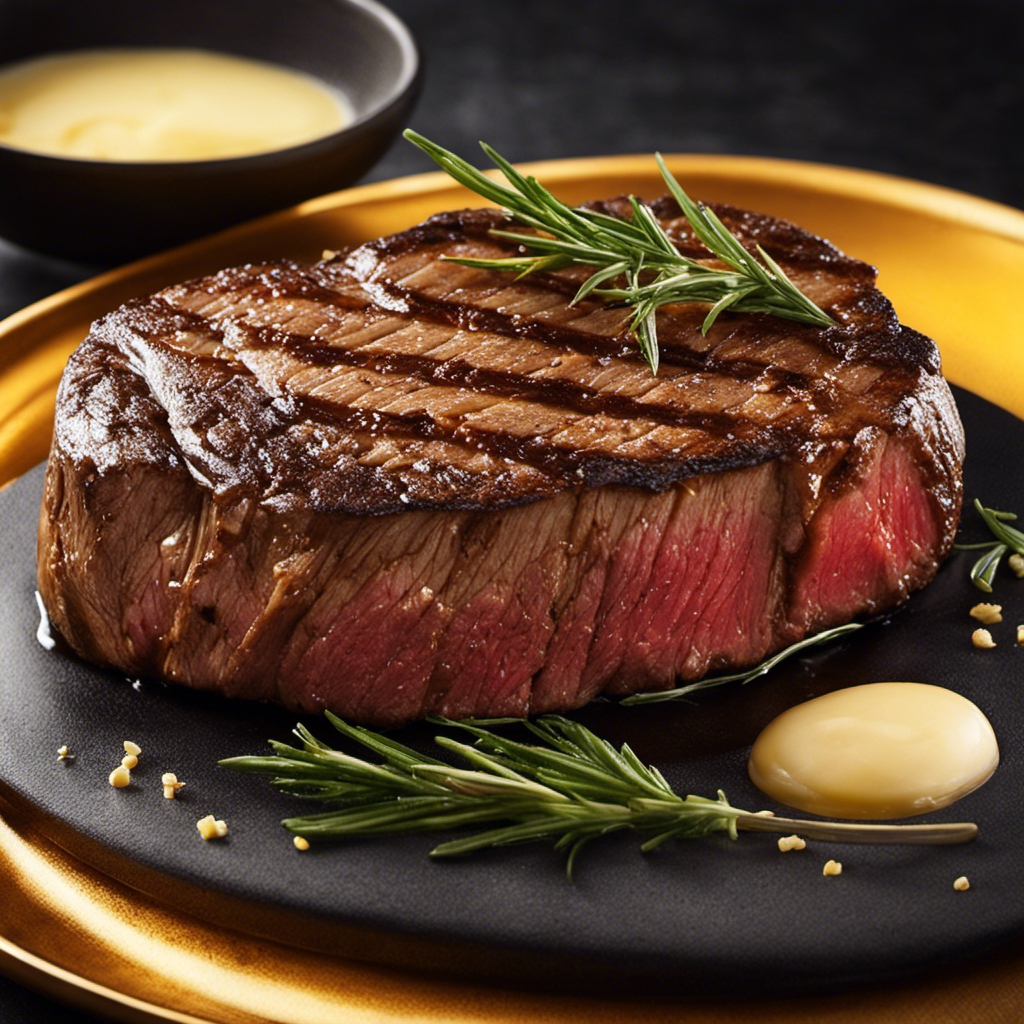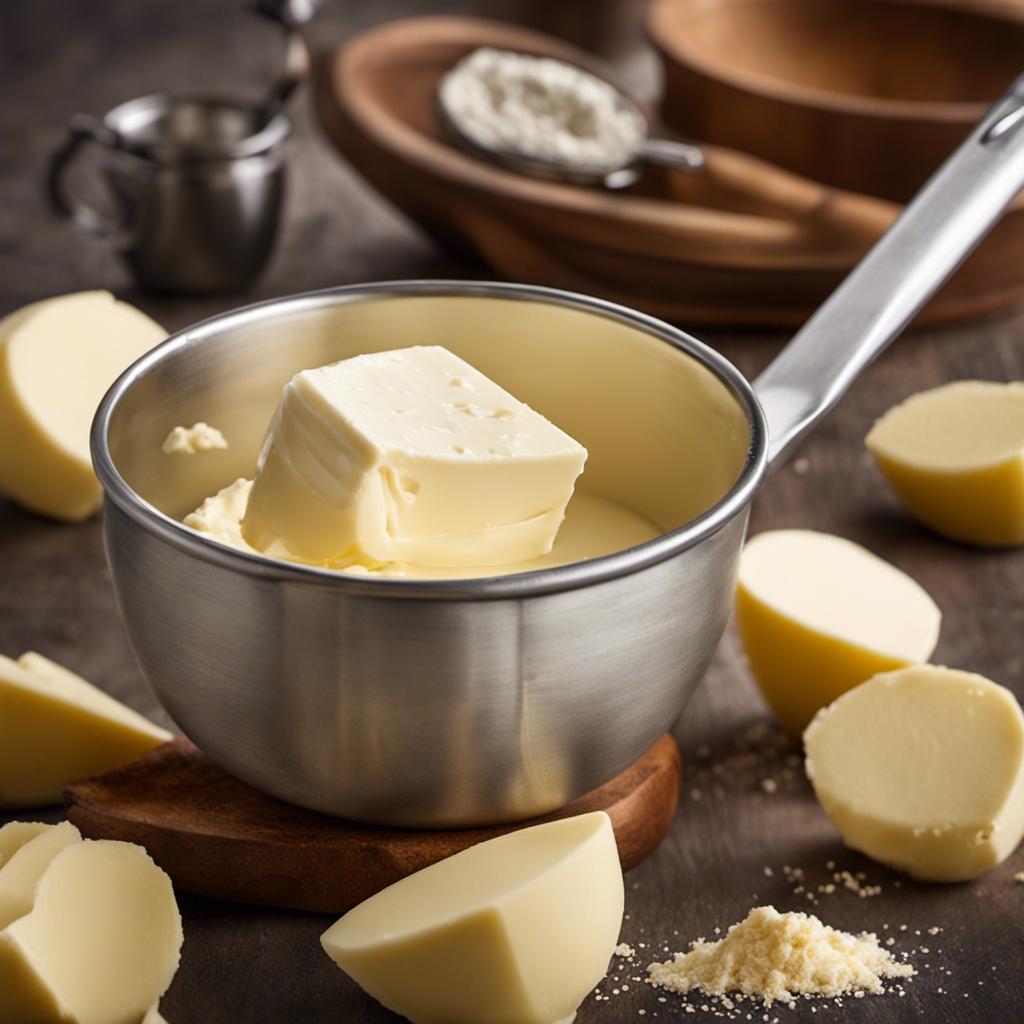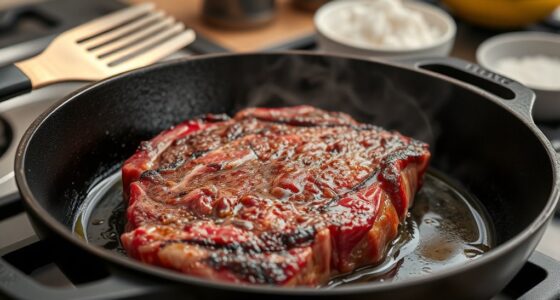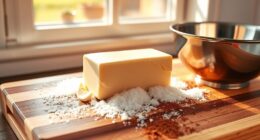I understand your doubts. The idea of making a butter churn may seem like a daunting task. However, I can guarantee you that the end result is truly rewarding.
In this article, I will guide you through the step-by-step process of creating your very own butter churn. With the right materials and a little bit of patience, you’ll soon be enjoying the rich, creamy goodness of homemade butter.
So, let’s roll up our sleeves and get started!
Key Takeaways
- Choose durable and aesthetically pleasing materials
- Take precise measurements and follow safety precautions
- Assemble the churn carefully and resolve any issues
- Optimize the churning mechanism for smooth operation and efficiency
Selecting the Right Materials
When making a butter churn, it’s important to select the right materials for the job. Choosing materials that are durable and aesthetically pleasing is essential in creating a churn that will stand the test of time and also add charm to your kitchen.
There are several cost-effective options available for selecting the right materials for your churn. One option is to use a sturdy wooden barrel for the churn body. Wood is not only durable, but it also adds a rustic and traditional look to the churn.
For the churn handle, a strong metal rod or wooden dowel can be used. These materials offer durability and ease of use.
Measuring and Cutting the Wood
After measuring and cutting the wood, it’s important to ensure the pieces are the correct size for assembly. Woodworking techniques require precision and accuracy, so taking careful measurements is crucial.
I always use a tape measure or ruler to measure the length, width, and thickness of the wood. I then mark the measurements with a pencil before making the cuts.
When cutting the wood, I follow safety precautions to prevent accidents. I wear protective goggles to shield my eyes from any flying debris, and I secure the wood firmly in place before making any cuts.
It’s also important to use sharp tools to ensure clean and accurate cuts.
Assembling the Churn Base
To assemble the churn base, you’ll need to align the pieces carefully and secure them together using screws or nails. It’s important to choose the right tools for this task to ensure a sturdy and durable churn. A power drill or screwdriver will make it easier to insert the screws, while a hammer can be used for nails.
Make sure to line up the edges of the pieces before fastening them together to ensure a tight fit. If the pieces don’t align properly, you may need to adjust them or check if any of the wood needs trimming. Common issues that may arise during assembly include loose screws or nails, which can be resolved by tightening them or replacing them if necessary.
With the churn base successfully assembled, we can now move on to building the churning mechanism.
Building the Churning Mechanism
When it comes to building the churning mechanism for a butter churn, there are several key points to consider.
First, selecting the right materials is crucial for ensuring the durability and functionality of the churn.
Additionally, making thoughtful design choices can optimize the churning process and improve efficiency.
Assembling the mechanism correctly is essential to ensure smooth operation.
Lastly, troubleshooting can help identify and resolve any issues that may arise during the churning process.
Material and Design Choices
The best material for a butter churn is wood because it is durable and provides a traditional look. When it comes to material selection for a butter churn, there are a few important design considerations to keep in mind:
-
Durability: Wood is a sturdy material that can withstand the rigorous churning process. It is less likely to crack or break compared to other materials like plastic or metal.
-
Heat insulation: Wood provides excellent insulation, which is crucial for maintaining the ideal temperature for churning butter. It helps to keep the butter cool during the process, preventing it from melting or becoming too soft.
-
Aesthetics: Wood adds a touch of rustic charm to the butter churn. It gives it a traditional and authentic look that many people appreciate.
Considering these factors, it is clear that wood is the ideal choice for a butter churn. Its durability, heat insulation, and timeless appeal make it the perfect material for a homemade butter churn.
Assembly and Troubleshooting
One important step in assembling the butter churn is ensuring that all the parts fit together properly. This is crucial for the smooth functioning of the churn and the efficient production of butter. Troubleshooting tips can help address common assembly mistakes that may occur during this process.
One common mistake is not aligning the paddle and the lid correctly. To avoid this, it is important to carefully follow the manufacturer’s instructions and ensure that the paddle is properly inserted into the lid.
Another common mistake is not securing the handle tightly, which can result in it coming loose during operation. It is important to tighten the handle securely to prevent this from happening.
Adding the Churn Lid and Handle
Attach the churn lid and handle to the butter churn securely. This step is crucial for proper functioning and to prevent any accidents during the churning process. To ensure a tight and secure attachment, follow these steps:
- Place the churn lid on top of the churn barrel, ensuring it sits evenly.
- Align the handle’s holes with the holes on the churn lid.
- Insert the handle screws through the holes, making sure they go all the way through.
- Secure the handle with nuts on the inside of the churn lid, tightening them firmly.
- Double-check the attachment by giving the handle a gentle shake to ensure it is stable.
Regularly inspect the churn lid and handle for any signs of wear or damage, replacing them if necessary. Clean the lid and handle after each use to prevent buildup of residue.
Finishing Touches and Testing the Churn
In this discussion, I will be covering the final steps of making a butter churn. These steps include the churn stability test, applying the final paint or varnish, and enhancing the churn mechanism.
Firstly, it is important to ensure the stability of the churn. This can be done by conducting a test to confirm that it is sturdy and well-balanced. This test will help ensure that the churn can withstand the vigorous churning process without toppling over or causing any accidents.
Secondly, applying a final coat of paint or varnish is crucial. This not only adds a polished look to the churn, but also provides protection against moisture and wear. The paint or varnish acts as a barrier, preventing the wood from absorbing moisture and potentially causing damage. Additionally, it gives the churn a more aesthetically pleasing appearance.
Lastly, enhancing the churn mechanism involves making any necessary adjustments or modifications. This step is important to ensure smooth and efficient churning of the butter. It may involve tightening or loosening certain parts, lubricating the mechanism, or even replacing any worn-out components. These enhancements will help optimize the churn’s performance and make the butter-making process more effective.
Churn Stability Test
To ensure your churn is stable, you’ll need to perform a churn stability test. This test is crucial in determining the efficiency and effectiveness of your churn in producing butter. Here are some key points to consider when conducting a churn stability test:
- Ensure the churn is properly assembled and all parts are securely fastened.
- Fill the churn with a known quantity of cream and start the churning process.
- Observe the churn’s stability during the churning process.
- Look for any signs of wobbling or excessive shaking.
- Monitor the churn’s ability to maintain a consistent speed and motion.
- Check for any irregularities or fluctuations in the churning process.
- Measure the time and effort required to churn the cream into butter.
Final Paint or Varnish
When applying the final paint or varnish, you’ll want to ensure that you have a smooth and even coat to achieve a professional finish. To begin, lightly sand the surface of the churn to remove any imperfections or rough areas. This will create a smooth base for the paint or varnish to adhere to.
Next, apply a thin layer of primer to further enhance the surface and improve the adhesion of the final coat. Once the primer is dry, use a fine-grit sandpaper to lightly sand the surface again, creating a smooth and even texture.
Enhancing Churn Mechanism
For optimal performance, it’s important to ensure the churn mechanism is properly enhanced. Improving efficiency in butter churning can be achieved through various alternative methods. Here are a couple of ideas to consider:
-
Adjusting gear ratios: By modifying the gear ratios in the churn mechanism, you can optimize the rotational speed and torque, resulting in a more efficient churning process. This can be done by either increasing or decreasing the number of teeth on the gears, depending on the desired outcome.
-
Utilizing an electric motor: Instead of relying solely on manual labor, incorporating an electric motor into the churn mechanism can significantly improve efficiency. The motor can provide consistent and powerful rotational force, allowing for faster and more consistent churning.
Frequently Asked Questions
How Long Does It Take to Churn Butter Using This Homemade Churn?
Using this homemade churn, it typically takes around 20-30 minutes to churn butter. However, time-saving techniques such as using a stand mixer or alternative churning methods like shaking a jar can reduce the time significantly.
Can I Use Any Type of Wood for the Churn Base?
I love using different types of wood for my churn base. Oak is sturdy and reliable, while cherry adds a touch of elegance. However, if you’re looking for alternative materials, you can also consider using stainless steel or food-grade plastic.
What Type of Wood Finish Should I Use to Protect the Churn From Moisture?
For moisture protection on a churn, the best wood finishes are polyurethane, varnish, or tung oil. These wood finishing techniques create a protective barrier that seals the wood and prevents moisture from seeping in.
Is It Possible to Modify the Churn to Make Whipped Cream Instead of Butter?
Yes, it is possible to modify the churn to make whipped cream instead of butter. By adjusting the speed and duration of churning, you can create a light and fluffy whipped cream. It’s just one of the many different uses for a butter churn.
How Do I Clean and Maintain the Churn to Ensure Its Longevity?
Cleaning and maintaining the churn is crucial for its longevity. To ensure its proper functioning, I follow the best practices by using gentle cleaning methods and regularly inspecting and oiling the moving parts.
Conclusion
In conclusion, making a butter churn is a rewarding and practical project that anyone can tackle. By following the steps outlined in this article, you can create a sturdy and efficient churn that will make butter-making a breeze.
Remember to choose the right materials, measure and cut the wood accurately, assemble the base and churning mechanism carefully, and add the lid and handle securely.
With a few finishing touches and some testing, you’ll have a functional churn ready to use. So, why not give it a try and enjoy the satisfaction of making your own butter?
